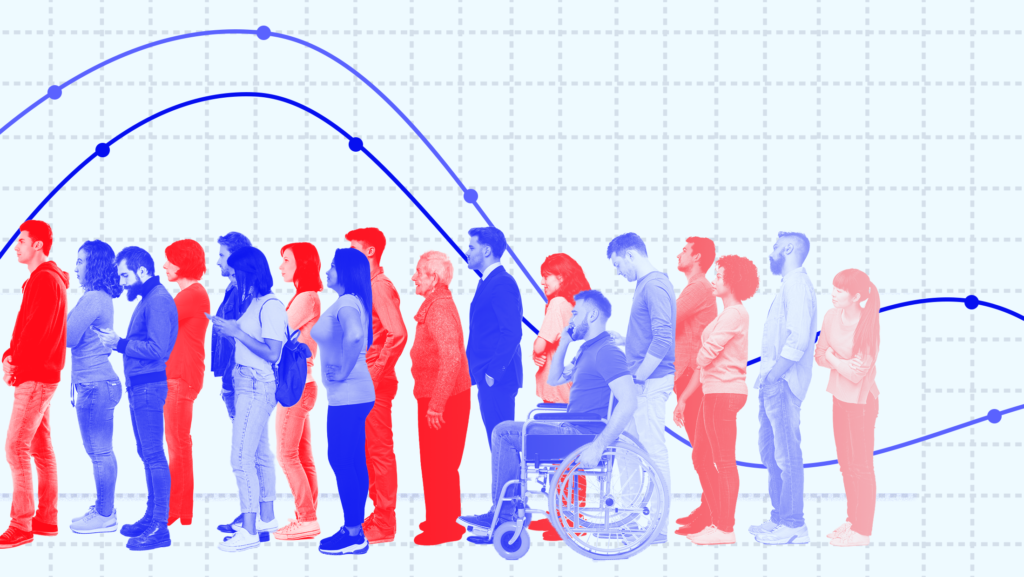How Long Lines Affect Turnout

It’s as American as apple pie — long lines on Election Day, that is. Every year it seems we get story after story about Americans waiting in long lines to vote, a problem that may grow worse as officials in some states seek to close polling places. But besides being inconvenient for voters, what effect do long lines have on them and their behavior in future elections? A recent paper by a University of Pennsylvania political scientist seeks to answer this exact question. The study, “The downstream consequences of long waits: How lines at the precinct depress future turnout” found that long lines have a significant impact on future turnout, with a particularly heavy impact on minority voters.
Here are the key takeaways:
1. Every additional hour a voter waits in line decreases the probability they will vote in the next election by 1%.
Trying to estimate the impact of lines at the polls on future turnout is complicated by numerous other factors and it’s difficult to control for all these variables without a randomized experiment. The study gets around these challenges by running statistical models on voting data from Catalist, a vendor that compiles vote history data from across the country. Using voting data from the 2012 presidential election and the 2014 midterm elections, the study found there is a significant, negative relationship between the amount of time someone waited to vote in 2012 and their probability of voting in 2014. Through a linear regression, the study shows that a voter who did not wait in line had a 57.6% chance of voting in 2014, while a voter who waited an hour in 2012 had just a 57.0% chance. The negative experience of waiting in line meaningfully reduced the likelihood of voting.
The study also used exact matching statistical models to pair voters from the same state, who are the same race, who have an identical vote history in the 2006, 2008 and 2010 elections and who come from similar neighborhoods. This matching model confirmed the results of the regression, finding that voters who live in a neighborhood with an average wait time of more than an hour were 1.6% less likely to vote in 2014 than their counterparts in a neighborhood with a wait time of less than 15 minutes.
Beyond the level of individual voters, the study also analyzed how lines at different precincts impacted the precinct’s turnout in the next election. Using data from Boston, which has not changed precinct boundaries in nearly a century, the study found that every additional hour late a precinct closed (a proxy for line length), the turnout at the precinct in subsequent elections decreased between 0.58% and 0.87%. Similarly, an analysis of precinct data from Florida showed precincts that closed later in 2012 had lower turnout in the next election. All in all, the evidence demonstrates that long lines diminish voter turnout by about 1%.
2. While 1% may seem small, the study suggests 192,000 voters did not vote in 2014 because of the amount of time they had to wait in 2012.
Polling place lines reducing the probability of voting by 1% may not seem like much, but as the study notes “a difference of 1 percentage point for the millions of voters who waited at least an hour is consequential.” The paper estimates that of the 107 million people who voted in person in 2012, 192,100 did not vote in 2014 because they waited so long in 2012. In a low turnout election like the 2014 midterms, the “subtraction of 192,000 voters is not a meaningless one.”
This is especially true in close elections. In Arizona’s 2nd Congressional District, the winning margin in 2014 was just 121 votes. The paper’s model suggests about 258 people in that district did not vote due to long lines. While the study doesn’t go as far to suggest long lines decided the outcome in that election, it does suggest that there is “a realistic potential that poor management at polling places could have an impact on election results in close races.”
3. Long lines have a disparate impact on the turnout of minority voters.
In general, minority voters in the United States are more likely to face long lines in their polling places. As a result, the effect of lines on minority voters is disproportionate to their make up of the electorate. While Black Americans comprise 9.7% of the electorate in 2014, they made up 22% of the voters who didn’t vote due to long lines. Likewise, 5.1% of voters in 2014 were Latino but 9.7% of the reduced turnout in 2014 came from this group. Consequently, if voters no longer had to wait in long lines, in the long run, turnout would increase more in minority neighborhoods.
In recent years, the U.S. Supreme Court has handed down decisions weakening the Voting Rights Act’s protections against changes to election laws that cause long lines. Coupled with the recent failure of Congress to pass comprehensive voting rights legislation, this raises the possibility of more polling location closures and other administrative moves that make lines longer for voters.
As the paper shows, the impact of long lines isn’t trivial — it has real effects on turnout. Any policy change that leads to long lines must be viewed with skepticism for its potential to suppress turnout and it is imperative to continue to work to ensure voting is easily accessible to all voters.